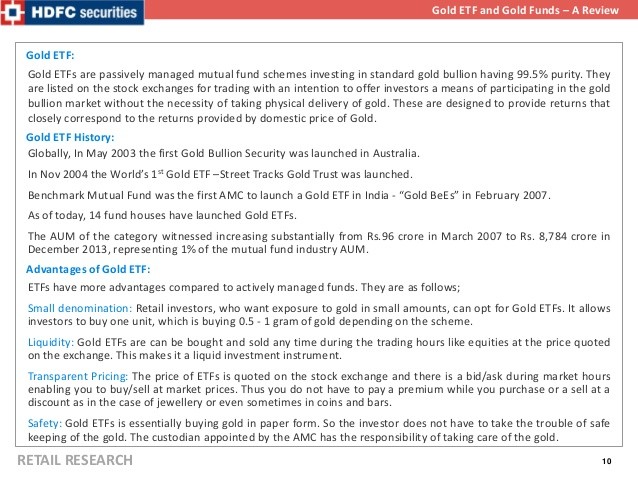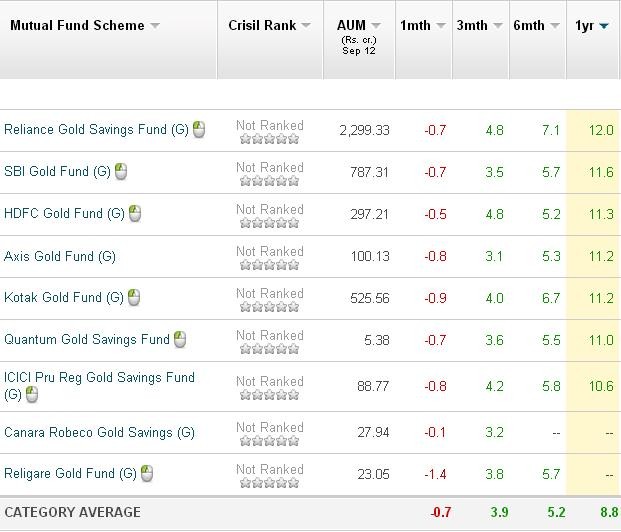Gold ETF Vs Gold Fund Of Funds
Post on: 7 Апрель, 2015 No Comment

Gold ETF Vs Gold Fund Of Funds
goldetfvsegold.blogspot.in/ ). However while going through the message boards of investment sites, I came across a growing number of questions on how does Gold Fund Of Funds (FOF) compare with Gold ETF and which one is better.
Why Gold ETF and Gold FOF, maybe because these are most marketed and easily available avenues of investment and probably due to their proximity or lineage to the stock markets and mutual funds. However to find an answer to the above question, following are the points which one needs to consider while investing in any one of the two gold avenues. There are a growing number of avenues through which one can invest in gold and hence the following points are aimed at bringing the facts on the table.
First let’s understand what is a Gold ETF and What is a Gold Fund of Funds.
Gold ETFs
Gold ETFs invest in physical gold and the closely tracks the price of gold As Closely As Possible, subject to tracking error. It is similar to buying any other share from the stock exchange or from secondary market. Typically each unit of gold ETF represents one gram of gold which means if a person buys 10 units of Gold ETFs then the AMC actually purchases 10 grams of Gold which is maintained by the AMC. There is no obligation on the investor to take the delivery of gold in physical form at the time of selling the Gold ETF units. The delivery can be taken in demat form or in physical form based on certain conditions which varies from AMC to AMC. Usually each unit of Gold ETF represents one gram of Gold with the exception of Quantum Gold ETF wherein each unit of Gold ETF represents half a gram of gold.
Gold Fund of Funds
Gold Fund Of Funds are nothing but mutual funds which invest in the majority of the corpus in gold ETFs from the same sister company, which means the underlying investment of Reliance Gold Savings Fund will be in Reliance Gold ETFs. Gold FOFs invest 90-100% in Gold ETFs from the sister company whereas the remaining 10% can be invested in money market instruments or debt instruments.
So if both invest in Gold ETFs directly or indirectly then what’s the difference and why two separate instruments. Here are some of the facts about the two instruments and how do they differ
1. Account Opening
To be able to invest in Gold ETF you need a demat account and a trading account with a broker or with an AMC. This involves account opening charges and maintenance charges. There is also a fund management fee also referred to as the expense ratio (usually 1%) which gets deducted from the NAV of the fund.
On the other side to invest in Gold FOFs, one does NOT need a Demat account and a Trading Account and the investment can be done by filling up an application form similar to how investments in other types of MFs are done.
2. Option of SIP or STP
There is no option of SIP for Gold ETFs, one has to manually initiate the purchase of Gold ETF units through demat account, however nowadays AMCs do provide an option of DIYSIP (Do It Yourself SIP) through which one can give standing instruction to the AMC / Bank for purchasing predefined Stock Units at the market price and on a particular date. However this option involves transaction cost like Securities Transaction Tax, brokerage and service tax, the only advantage is it works on the same lines as SIP and one does not have to login in to his / her account and initiate a purchase transaction for the stock units / ETF units. The DIYSIP option is available in HDFC as well as in Reliance Money.
On the other hand, SIP option is available in Gold FOFs as well as STP transfers are also applicable for Gold FOFs. Again with the advent of Swing STP from HDFC and Value STP from ICICI, one can even take the advantage of Value Cost Averaging in Gold FOFs.
3. Investment Amount
Since Gold ETFs closely represent one gram of Gold, the investment amount needs to be a minimum equivalent of one of gold. In Quantum Gold ETF, the investment amount should be a minimum equivalent of half a gram of gold.
In case of Gold FOFs, the investment amount does not necessarily be equivalent to one or half gram of gold unit. The initial minimum amount is Rs 5000/- but the SIP investments can go as low as Rs 100/- (in case of SBI Gold Fund).
4. Exit Load
Since Gold ETFs are traded like any other shares, buying and selling in the stock exchanges or secondary market, Exit load is not applicable for Gold ETFs.
On the other hand, Gold FOFs do have exit load of 1 — 1.5% if the units purchased are sold within one year from the purchase date. Some even have 2% if the redemption of units are done within 181 days from the date of purchase whereas 1% if the redemption is done within 181-365 days from the date of purchase.
5. Expense Ratio / Fund Management Charges
Most gold ETFs have an expense ratio of 1% except for Motilal Oswal Gold ETF, a recently launched gold ETF scheme, wherein the expense ratio is 1.3%.
On the other hand since Gold FOF is a fund of funds, the expense ratio is of fund as well as of the underlying ETF schemes. So on an average the expense ratio turns out to be 1.5% in case of Gold FOFs. This basically leads to an added cost to the investor. The added cost here may be in the range of 0.5-0 .75% and it will bring down the returns to that extent. In a bad year, if gold delivers single-digit returns then such costs appear as a drag on the fund returns.
Gold ETFs do incur Transaction cost and brokerage for every new investment, however Gold FOFs on the other hand have a higher expense ratio which for long term investments (investments more than 5 years) can prove to be a drag on the returns. The Gold FOFs expense ratio of 0.5 to 0.75% is higher than the STT and brokerages applicable. I have not considered Demat Account charges as the demat account charges will be distributed for other investments as well or they can be negotiated with the AMC for better rates. Again there are certain AMCs which have NIL expense ratios for the Gold FOFs (HDFC and Religare) in which case the gold FOFs stand out.
6. Volatility
For those who are actively involved in the market as Traders, then the gold FOFs will not work for them because the Net Asset Value of the fund at which the fund sells the units is based on closing NAV calculated based on the price of the gold on the previous day. However, for active traders, gold ETFs provide an opportunity to benefit from sudden price movements of gold as the prices of gold ETF reflect the value of the underlying gold on real time basis rather than on the price of the gold yesterday
7. Liquidity
Gold ETFs do provide a better liquidity than the Gold FOFs, as Gold ETFs are traded like stocks and one can buy and sell through the demat account that one holds. However currently one important point to be considered here, if we look at the volumes of ETFs traded in the market, the volumes are pretty low as compared to average stocks being traded. This means one may end up selling the units at a discount or one may end up buying the units at a premium. On the other hand Gold FOFs also provide an easier way to liquidate the holdings and specially if one has a demat account or can transact online. In case one does not have a demat account or does not have an online transaction account with the AMC, then liquidating the holdings can be bit difficult and time consuming.
8. Redemption Of MF Units
Gold ETFs do provide the option for one to take the delivery in Physical Form at the time of selling the units. For example if one holds 1000 units of HDFC Gold ETF which is equivalent to 1000 gms of gold i.e. 1 KG, then at the time of selling he can take the delivery in physical form i.e. physical gold. The number of units that can be redeemed in physical form varies from AMC to AMC, for example Motilal Oswal Gold ETF has the criteria as low as 10 gms.

On the other hand, Gold FOFs can be redeemed only in Demat Form and not in physical form.
9. Taxation
From a taxation perspective, Gold ETFs even though traded as stocks are taxed as debt mutual fund schemes. Also Gold FOFs get similar taxation as debt mutual fund schemes.
If you hold gold ETFs or Gold FOFs for more than a year, you pay a long-term capital gains tax of 10 per cent without indexation or 20 per cent with indexation, whichever is lower, on the profits made.
Gold ETFs or Gold FOFs held for less than a year attract short-term capital gains tax. Meaning the profits are added to your annual income and taxed according to the bracket your income falls in.
In case the delivery of MF units is taken in physical form than that will attract Wealth Tax.
Basically prior to investing in any one of the avenues, one needs to consider the above factors.
Conclusion is
1. If you are not an active equity market investor,
2. Want to have investments only in MFs and not in equities (as demat account will not be required) and
3. Have a proper selection of fund (funds which do not charge additional expense ratio percentage over and above the underlying gold ETF fund)
4. Want to take advantage of the Value Cost Averaging Facility through Swing STP / Value STP
4. Not planing to redeeming MF units in Physical Form
Than Gold FOF turns out to be right option.
Else if the gold FOF is charging a separate expense ratio over and above the underlying Gold ETF then I would suggest Gold ETF from a long term perspective.














